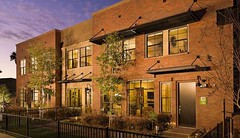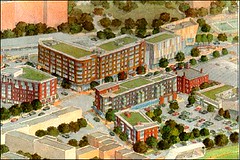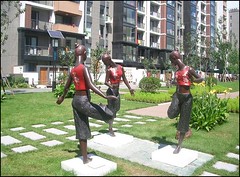The new LEED-ND standards: what’s new, what’s good, and what’s not (part 1)

Posted May 7, 2009 at 1:37PM
I've now been working on LEED for Neighborhood Development for seven years. That's longer than anyone else who is currently involved, though architect Doug Farr has been in our merry band for almost as long. NRDC has been a sponsor and partner from the beginning, even before the US Green Building Council became involved and we started calling it "LEED." We have always seen our role as representative of the larger smart growth and environmental community, and we coordinate regularly with Smart Growth America and other fellow travelers. The Congress for the New Urbanism has been our partner from day one.
NRDC's goals for LEED-ND, and a brief intro
That's a long way of saying that I am not at all free of bias or investment in this process. If you're looking for pure objectivity, you won't find it here. I want LEED-ND to succeed. But I also want it to succeed in a certain way: the program should comprise a set of standards that defines what is smart about smart growth, separates true environmentally superior land development from the pretenders, and rewards developers who are leading the way, in the right locations with the right design.  And I am just as determined that the program not bestow its honors - and NRDC's goodwill - on developments in the wrong places or with the wrong design.
And I am just as determined that the program not bestow its honors - and NRDC's goodwill - on developments in the wrong places or with the wrong design.
Put another way, an urbanist design with green buildings in a sprawl location is not smart growth, and neither is mediocre, unwalkable design in urban locations. There are plenty of other award programs to highlight good design; this one is for the developments that have good design in the right places.
Note also that LEED-ND doesn't prevent anything. It only defines that category of development worthy of green certification.
Where we are in the process
LEED-ND has been in a pilot program now for a couple of years, and we have learned from it, certifying 26 projects (as of this writing) along the way. (Images presented with this post are of projects certified under the LEED-ND pilot.) We hope to go full-scale this fall. And last week we published a new set of fully revised standards for public comment. Comments must be made online by June 14 and, if you are reading this blog, chances are that you may have an opinion to express about what we've done. I hope you will.
The program's standards are by their nature highly technical (and, from here on out, so is this post). But the technicalities matter. We have both prerequisites and credits in three major categories: smart location and linkage (the "where" of smart growth); neighborhood pattern and design (the "what"); and green infrastructure and buildings ("how" to ensure optimum performance). To be certified, a development must meet all the prerequisites and earn a mininum number of points from the menu of credits.
For what it's worth, here are some of my opinions about the details in the new draft that matter most, starting with the smart location and linkage category. (I should add here that, in committee, I supported most of the standards below, in some cases because they seemed the best outcomes we were likely to get. That doesn't mean that I am satisfied with all of them.)
The smart location prerequisite
Known affectionately inside LEED-ND circles as "SLLp1," the location prerequisite is the most important single standard in the system. It is designed primarily to exclude leapfrog development from green certification unless the project at least has regular transit service or is within walking distance of an existing community.  The original draft of this requirement, which never made it to publication, did a decent job at that, but processes like the construction of LEED-ND end up being a set of compromises. This is especially the case given that NRDC's two partners in the undertaking, CNU and USGBC, are both primarily private-sector organizations with members standing to benefit from LEED-ND certification.
The original draft of this requirement, which never made it to publication, did a decent job at that, but processes like the construction of LEED-ND end up being a set of compromises. This is especially the case given that NRDC's two partners in the undertaking, CNU and USGBC, are both primarily private-sector organizations with members standing to benefit from LEED-ND certification.
The new draft of the location prerequisite is weaker than I wish in two respects: First, it treats projects with planned transit as if they have actual, existing transit service. This makes some sense in the case of fixed-rail transit, where lead times are long and station-stops are known far in advance; developing in those known locations is smart. But planned bus service is much less certain, especially given SLLp1's wording that service need be provided only when the development is 50% occupied. Given the 20-30-year lead times of some master-planned communities, this means that a project could qualify as "transit-served" even when there is really no transit at all for a full decade or more. That's not good enough, in my opinion: LEED-ND should require that projects seeking green certification as transit-served have bus service, at least, from the beginning.
Second, the pathway for new projects adjacent and connected to good existing development was weakened in this round. The definition of "adjacent site" now allows a 400-foot leapfrog across green space to be considered as "adjacent." The argument advanced by the determined development reps on the committee was that this would allow for wildlife corridors and such; maybe so, but in my opinion the project should at least have transit to qualify for green certification if that's what it does. In addition, the infrastructure density standard that serves as a proxy to define existing good development was reduced from 150 to 90 intersections per square mile, only marginally better than conventional sprawl. The argument advanced in favor of this one was that we need to "heal" sprawl. But I don't think that expanding the development footprint is the way to do that, particularly in the absence of transit. Suburban infill should come before suburban expansion.
There were other changes but those are the biggies. The rest of SLLp1 is pretty good.
The wetlands and water body prerequisite
On this standard ("SLLp3"), there is good news and bad news. The good news is that, while the previous drafts allowed a limited percentage of wetlands or water bodies and their buffers to be disturbed, particularly for high-density projects, the new draft makes the wetlands and water bodies themselves inviolate and allows disturbances only in their buffers.  That is an important change that smart growth advocates should support. The bad news, however, is that the required buffer for wetlands was reduced from 100 to 50 feet. That is consistent with the position taken in the American Society of Landscape Architects' much-heralded Sustainable Sites Initiative, but it is a reduction of the protected zone.
That is an important change that smart growth advocates should support. The bad news, however, is that the required buffer for wetlands was reduced from 100 to 50 feet. That is consistent with the position taken in the American Society of Landscape Architects' much-heralded Sustainable Sites Initiative, but it is a reduction of the protected zone.
As before, the standard allows disturbances in up to 20% of the buffer, depending on the density of the project. That would seem to defeat the purpose of having a buffer, but at least disturbances within 50 feet of water bodies or 25 feet of wetlands are allowed only if certified by a qualified biologist.
The agricultural land prerequisite
At least the new farmland standard is a little better than the old, which was embarrassingly weak and exempted almost all sites from the requirement to avoid prime soils. We were sharply criticized for it in the previous round of commenting, and rightfully so. The argument against a stronger standard that has been persistently advanced by the development representatives on the LEED-ND committee is that developers in the Midwest would choose not to participate in the program rather than avoid prime farmland. I'm not entirely clear on why that would be such a terrible thing, myself - LEED has always been for the builders that go the extra mile - but that's the argument.
Changes to the standard were hotly debated. The proposal favored by the smart growth wing of the committee would have required that, to be eligible for green certification, a development either avoid prime farmland or mitigate the conversion by purchasing offsite conservation easements that would protect other prime farmland in perpetuity. This was, we thought, an acceptable compromise.
Not to put too fine a point on it, we lost. The new standard is a further compromise that requires mitigation, but only for the lowest-density projects, those with fewer than ten units per acre in smaller metro regions and those with fewer than 13 units per acre in larger regions. There is a sliding scale, by density, to determine how much mitigation the low-density projects must undertake. Projects served by transit or planned transit will be exempted regardless of density. My take is that prime farmland just doesn't get much love in LEED-ND. We tried.
The location credits
These weren't changed very much, and that's a good thing. The system's credit points will still reward the projects in the locations that allow superior environmental performance.
The most important changes were to the credit ("SLLc3") for locations with reduced automobile dependence (levels of transit service or proven low driving rates).  The thresholds required to earn increasing credit points for increasing levels of transit service (which, unlike in the prerequisite, must be real, not just planned) were raised, in accordance with recommendations made by transit providers in the first round of public comments. That is an especially good change, because one of the things we learned in the pilot was that this credit was too easy to earn. Smart growth advocates should support the change.
The thresholds required to earn increasing credit points for increasing levels of transit service (which, unlike in the prerequisite, must be real, not just planned) were raised, in accordance with recommendations made by transit providers in the first round of public comments. That is an especially good change, because one of the things we learned in the pilot was that this credit was too easy to earn. Smart growth advocates should support the change.
The basic smart location credit ("SLLc1"), on its face, changed only in technical language. But the change to the definition of "adjacent site" allowing 400-foot leapfrogs over green space was mistakenly carried over to this credit. That was an oversight. Whatever the merits of a loose standard for "adjacency" in the prerequisite, a loose standard is clearly not appropriate for earning credit points, and the mistake should be fixed.
Among the remaining credits, the ecological credits (SLLc7, 8 and 9) were improved with a clearer emphasis on management. The others (along with the imperiled species prerequisite) are all imperfect for one reason or another, but they haven't changed much and are probably fine for the initial launch of LEED-ND. The program will be on a 2-year review-and-update cycle, so there will be opportunities for further refinement as we gain experience.
Next: the "neighborhood pattern and design" section.